If you’re one of the many proud owners of a stunning koi pond, you know just how mesmerizing these elegant creatures can be. However, to keep your fish healthy and happy, it’s crucial to maintain a clean and well-balanced pond environment. Not only will this benefit your fish, but it will also prevent costly repairs down the road.
In this section, we’ll explore essential koi pond maintenance tips. We’ll cover everything from planning and designing your pond to controlling algae and managing water quality. With our guidance, you’ll be equipped to create a serene oasis in your backyard that your fish can thrive in.
But first, let’s address the cost of koi pond maintenance. While it’s true that maintaining a pond requires some financial investment, there are ways to keep costs manageable. One option is to research reputable koi pond maintenance companies that offer affordable services. Or, you can choose to learn and execute the maintenance tasks yourself, which can ultimately save you money in the long run.
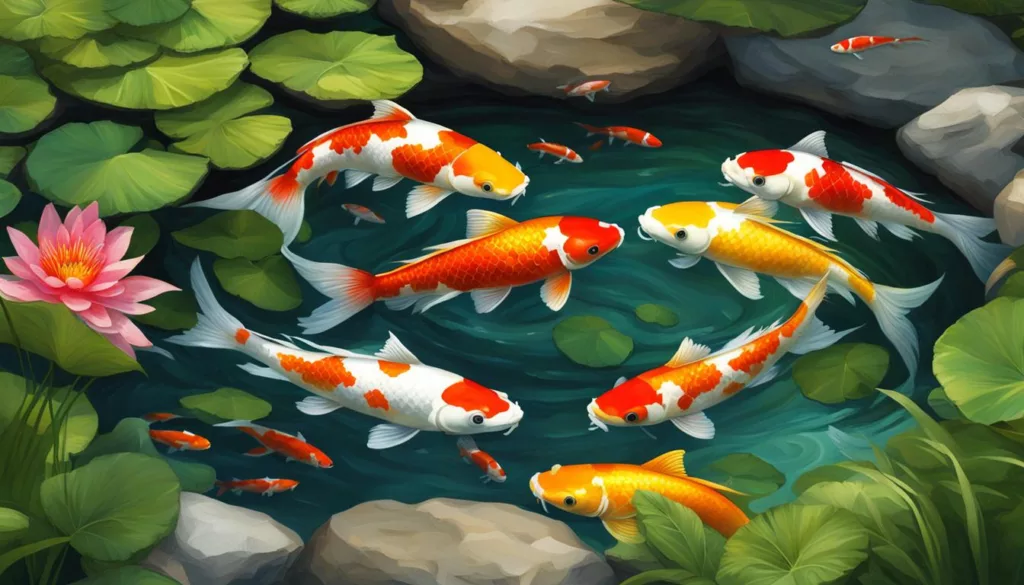

Key Takeaways:
- Maintaining a clean and well-balanced koi pond is essential for the health and happiness of your fish.
- Proper planning and design can help prevent costly maintenance issues down the road.
- Researching reputable koi pond maintenance companies can help keep maintenance costs manageable.
- Regular water testing, controlling algae growth, and preventing and treating diseases are key components of koi pond maintenance.
- Managing seasonal changes and protecting against external threats, such as predators, are also essential.
Planning and Designing Your Koi Pond
Creating a beautiful and functional koi pond requires careful planning and thoughtful design. Before diving into koi pond maintenance, it’s essential to have a well-considered plan in place. Here are some key factors to consider when designing your koi pond:
- Location: Choose a spot that receives adequate sunlight and shade to provide a healthy balance for the pond ecosystem. Ensure it’s also easily accessible for maintenance purposes.
- Size: The size of your pond will depend on factors such as the number of koi you plan to keep and the available space in your yard. Keep in mind that a larger pond is generally easier to maintain and provides more room for your fish to grow and swim.
- Shape: Koi ponds come in all shapes and sizes, from classic kidney-shaped designs to more irregular configurations. Your choice of shape should reflect your style while also taking into consideration the surrounding landscape and the needs of your fish.
- Materials: There is a range of materials to choose from, including concrete, fiberglass, and liners. Your choice will depend on factors such as budget, durability, and the aesthetic you’re trying to achieve.
- Features: Consider adding additional features such as waterfalls, rocks, or aquatic plants to enhance the appearance and functionality of your pond. These features can also provide additional filtration and aeration, which can improve water quality.
Once you’ve established a design plan, it’s essential to consider the costs associated with koi pond maintenance. A well-maintained koi pond requires regular attention to ensure it remains healthy and clean for your fish. The costs of maintaining a koi pond will vary depending on factors such as pond size, filtration system, and the number of fish you have. However, investing in high-quality equipment and regular maintenance can save you money in the long run by preventing costly repairs or replacements.
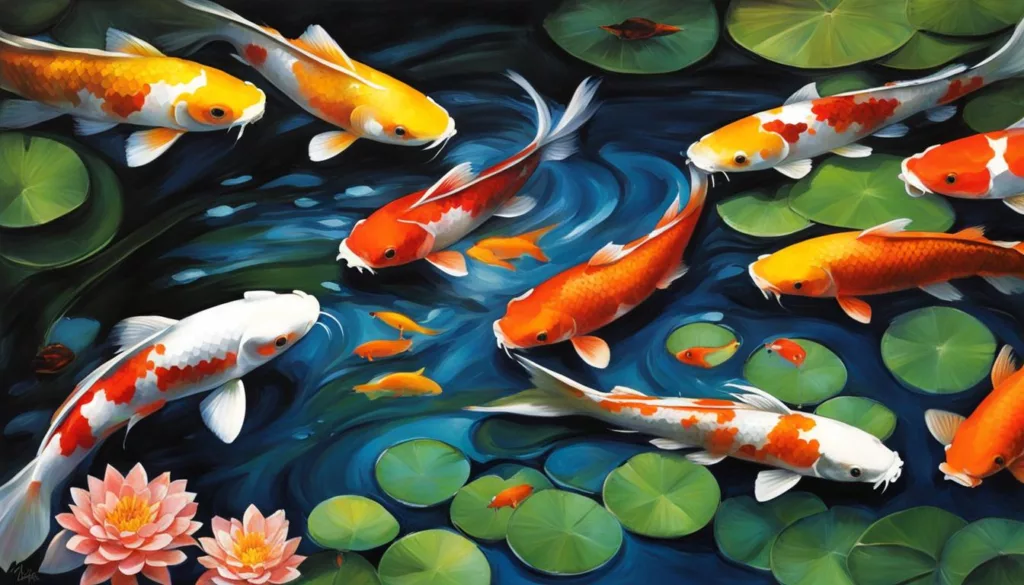

Cost Breakdown for Koi Pond Maintenance
| Expense Type | Cost Range |
|---|---|
| Koi food | $25-$200/month |
| Filtration system | $500-$5,000+ |
| Pump | $150-$800 |
| Chemicals | $50-$100/month |
| Professional services (cleaning, repairs, etc.) | $100-$300/month |
Keep in mind that these costs are estimates and may vary depending on your specific situation. Regular maintenance and attention to detail can help ensure that your koi pond stays healthy and beautiful year after year.
Choosing the Right Filtration System
Water quality is paramount when it comes to maintaining a healthy koi pond, and a reliable filtration system is fundamental to achieving this. With various filtration options on the market, it can be challenging to determine the most effective one for your pond. Understanding the benefits and costs associated with each type of filtration is crucial in making the best choice for your pond’s specific needs.
Biological Filtration: It is the most popular filtration system choice used by Koi enthusiasts since it simulates a natural filtration system that is beneficial for fish and their aquatic environment. These intricate and well-designed systems rely on naturally occurring bacteria to neutralize and remove toxins and debris from the water. Compared to other filtration systems, it requires less maintenance and is suitable for larger ponds. However, it can have a high start-up cost.
Mechanical Filtration: This system uses materials such as sponge filters, which sieve out particles, debris, and other large waste particles as water passes through. The maintenance requirements are higher with this option, as debris and filth will get trapped and clog the filters over time, requiring them to be cleaned and replaced more frequently. While the start-up costs are lower, the ongoing maintenance costs make this option more expensive in the long run.
Combination Filtration: This option combines both biological and mechanical filtration systems, offering the benefits of both filtration options for your koi pond. It is a popular choice among pond owners since it provides the best of both worlds. However, the filter needs to be monitored and maintained regularly, and it can be more costly than the other filtration options on this list.
| Filtration System | Main Benefits | Main Drawbacks |
|---|---|---|
| Biological | Efficient, natural environment, suitable for larger ponds, low maintenance | High start-up costs |
| Mechanical | Low initial cost, effective against large waste particles | Higher ongoing maintenance costs, less efficient |
| Combination | Offer the benefits of both filtration systems, efficient, low-maintenance | Higher start-up and maintenance costs |
No matter which filtration system you choose, it’s essential to factor in the associated maintenance costs. Poor maintenance can result in a contaminated and unhealthy environment for your koi that may even spread diseases. Consult with koi pond maintenance companies for insights on the best filtration system for your specific pond needs and maintenance requirements.
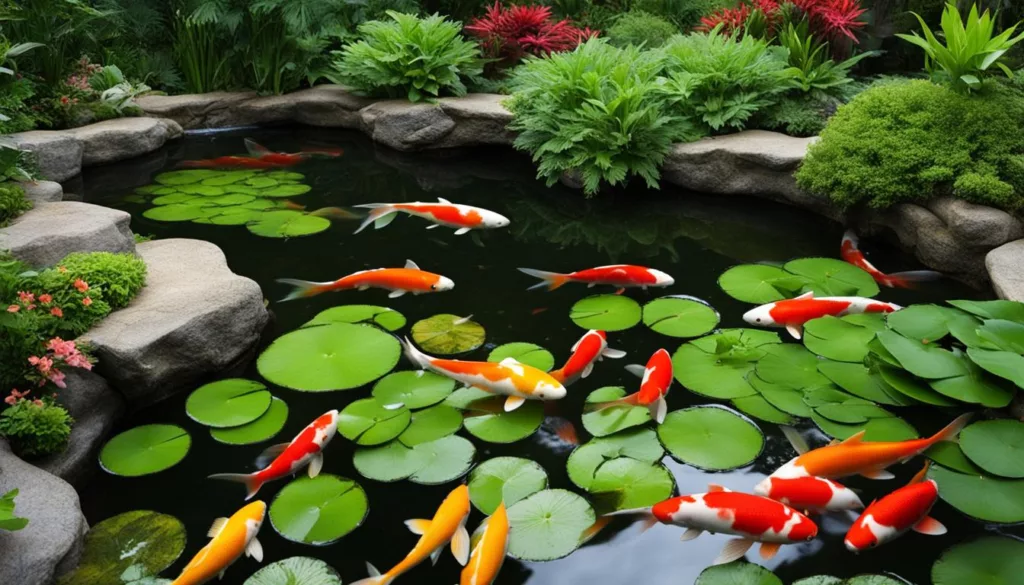

Managing Water Quality
Proper water quality is crucial for the health and well-being of your koi. Paying close attention to the following factors can help maintain optimal conditions for your fish:
- pH levels: Ensure that the pH levels are in the 7.0-8.0 range. Test the levels regularly and make adjustments as needed with appropriate pH balancers.
- Ammonia and nitrite levels: Test ammonia and nitrite levels frequently with a reliable test kit. Keep levels low to prevent health problems in your koi.
- Oxygen: Koi require sufficient oxygen levels for survival. Installing an aerator or waterfall can help increase oxygen levels in your pond.
- Temperature: The ideal temperature range for koi is between 60°F-75°F. Temperature affects koi metabolism, growth rate, and disease resistance. Keep your pond cool during hot summer months and properly heated during cold winter seasons with an appropriate heater.
- Alkalinity: Alkalinity measures the pond’s ability to buffer pH changes, and it’s essential for keeping the water stable. A level of 80-120 ppm is considered healthy for your koi.
Regularly monitoring and maintaining your koi pond’s water quality can help prevent any issues that may arise and keep your pond inhabitants happy and healthy.
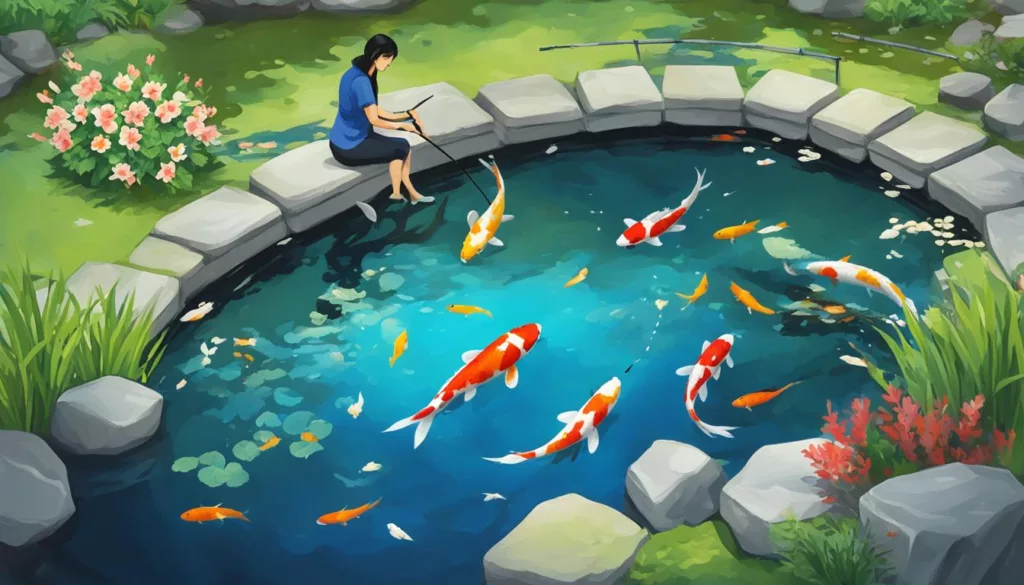

“Clean water is essential for healthy koi that can live up to 30 years or more. By ensuring optimal water conditions, you’re establishing a home in which your fish can thrive.”
Regular Water Testing
Regular testing of the water in your koi pond is crucial for maintaining their health. By measuring various parameters, you can detect any imbalances and make necessary adjustments to keep the water conditions optimal. The following are the essential water tests you should perform regularly:
| Parameter | Ideal Range | Test Frequency |
|---|---|---|
| Ammonia (NH3) | 0 ppm | Twice a week |
| Nitrite (NO2) | 0 ppm | Twice a week |
| Nitrate (NO3) | 10-40 ppm | Weekly |
| pH | 7-8 | Weekly |
| GH (General Hardness) | 100-200 ppm | Monthly |
| KH (Carbonate Hardness) | 100-200 ppm | Monthly |
Keep in mind that some factors, such as water temperature and seasonal changes, can impact water quality. Therefore, it is crucial to adjust your testing frequency accordingly to ensure that your koi are thriving in a healthy environment.
To make water testing easier, you can invest in a quality testing kit that contains all the necessary equipment and instructions. Most importantly, take note of the test results and compare them to the ideal parameters for koi ponds. By doing so, you will be able to identify any potential issues and intervene promptly before they become a more significant problem.
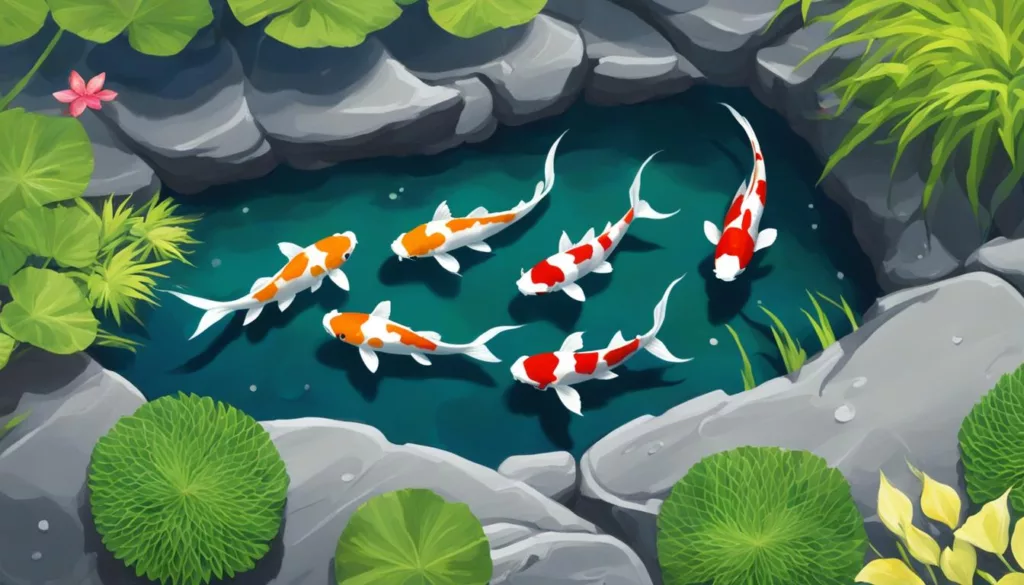

Feeding and Nutrition
Koi are known for their colorful and graceful patterns, which make them a popular choice for a backyard pond. However, maintaining the beauty and health of your koi requires proper feeding and nutrition. In this section, we will provide you with the necessary tips to establish a feeding routine, select suitable food, and avoid potential pitfalls that may impact your fish’s health.
Establishing a Feeding Routine
Feeding your koi is an essential part of their daily routine. Establishing a feeding schedule will ensure your fish receive proper nutrition while avoiding overfeeding, which can harm water quality. For adult koi, two to three small feedings per day are sufficient. However, during the cooler months, it is advisable to reduce the feeding frequency to once per day.
Selecting Suitable Food
Choosing the right food for your koi is essential to their overall health. Koi food comes in a variety of types and formulations, including pellets, flakes, and treats. Pellets are the most popular type of koi food as they offer balanced nutrition for your fish. However, it is important to select a formula that aligns with your fish’s growth stage, age, and overall health. It is also best to avoid overfeeding treats, as they can negatively impact your koi’s diet.
Avoiding Common Pitfalls
Overfeeding is one of the most common mistakes in koi pond maintenance. When you overfeed your koi, it results in an excess of uneaten food, which can lead to poor water quality and reduced oxygen levels. Additionally, overfeeding can cause health problems for your koi, such as swim bladder disease and obesity. You can prevent overfeeding by providing only the amount of food that your koi can consume in a few minutes.
Controlling Algae Growth
Maintaining proper water quality is crucial for the health of your koi. Algae growth is a common issue that can harm your fish and cloud the water, making it unappealing to look at. To keep your pond pristine, you need to take crucial steps to control algae growth.
Adding Aquatic Plants
Aquatic plants are a natural and beautiful way to control algae growth in your koi pond. They absorb nutrients that algae would otherwise consume, minimizing algae growth. Not only do plants help maintain water quality, but they also provide a natural habitat for your fish to explore. Examples of aquatic plants that you can add to your koi pond are:
| Aquatic Plants | Benefits |
|---|---|
| Water Hyacinth | Rapid Algae Absorption |
| Water Lettuce | Provides Shade |
| Hornwort | Absorbs Nutrients |
Adding aquatic plants to your pond is an excellent way to add some greenery and life to your aquatic oasis.
Implementing UV Sterilizers
Ultraviolet sterilizers are a popular way to prevent algae growth in your koi pond. UV sterilizers use ultraviolet light to kill single-celled algae, preventing it from growing and taking over your pond. It’s crucial to choose the proper size UV sterilizer for your pond, with the appropriate flow rate to ensure its effectiveness.
Maintaining Proper Nutrient Balance
Algae growth is directly proportional to the nutrient levels in your pond. By controlling the amount of fish food and waste, fertilizers from surrounding plants, and organic debris, you can minimize the amount of nutrients in your pond, reducing algae growth. Regularly cleaning your pond and filters is also necessary to keep nutrient levels in control.
Controlling algae growth is an essential aspect of koi pond maintenance that cannot be overlooked. By implementing the methods discussed above, you can maintain a crystal clear and healthy pond that both you and your fish will love.
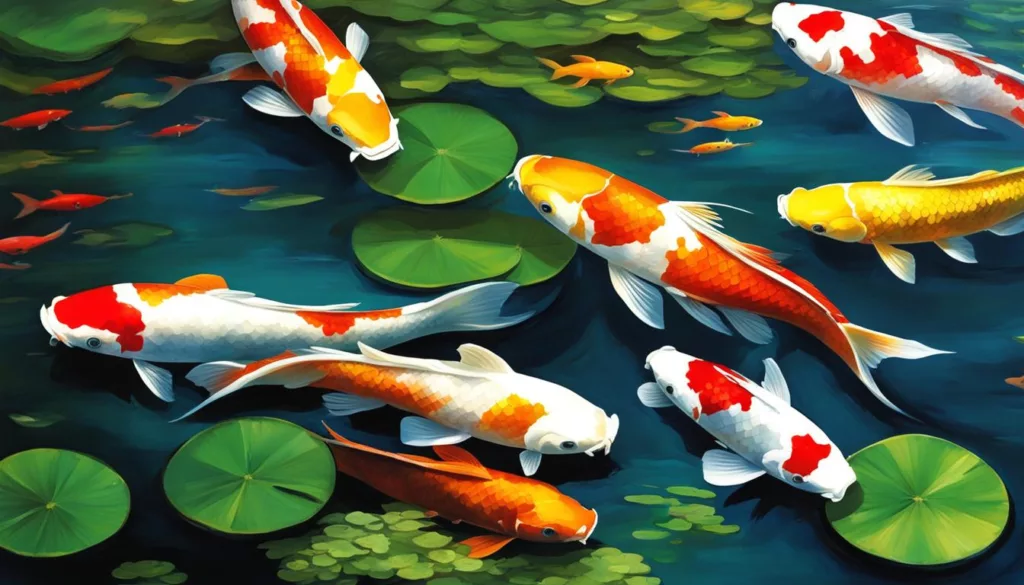

Preventing and Treating Diseases
Regular monitoring of your koi pond is essential in keeping your fish healthy. Despite your best efforts, fish diseases can still occur and spread quickly, potentially affecting your entire koi population. Fortunately, there are preventative measures and treatments available to help protect your fish.
Prevention
The best way to avoid diseases is to maintain a clean and healthy environment in your koi pond. Regular water changes and adequate filtration are vital in preventing bacterial and fungal infections. Avoid overfeeding your fish as uneaten food can pollute the water and attract harmful bacteria. Ensure that your koi are not overcrowded as this can cause stress, making them more susceptible to diseases.
Identification and Treatment
It is crucial to identify any signs of disease early to prevent it from spreading. Symptoms of diseases can include lethargy, loss of appetite, abnormal swimming behavior, and physical signs such as sores, ulcers, and discoloration. In the case of illness, it is best to isolate the infected fish and contact a veterinarian who specializes in fish medicine for advice on treatment options.
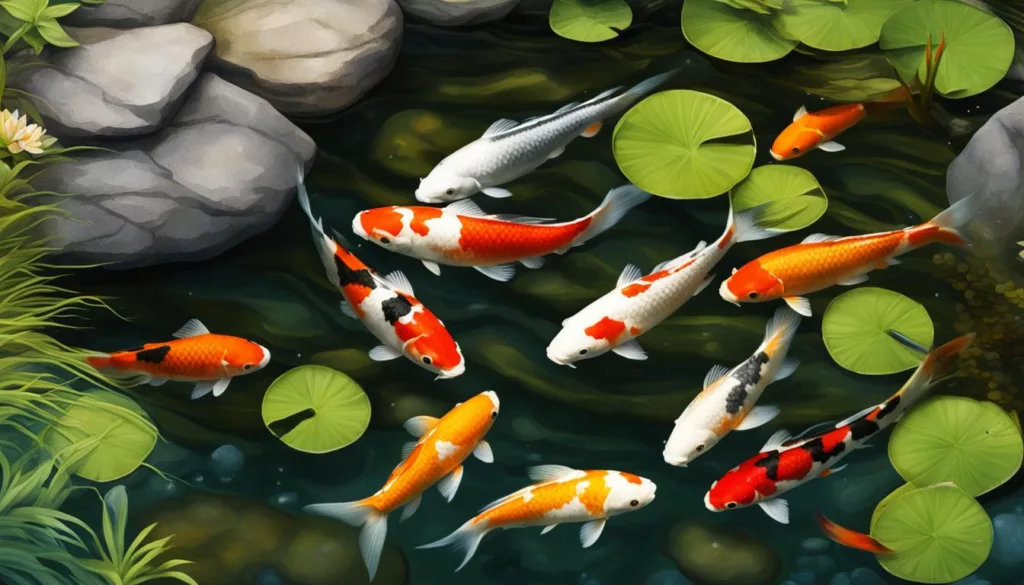

Note: When using chemicals to treat diseases, ensure that they are safe for your fish and follow the instructions carefully.
The key to preventing and treating fish diseases is to maintain a healthy koi pond through regular cleaning, monitoring, and proper nutrition. Be vigilant and proactive in your maintenance efforts and seek professional help when necessary to ensure your koi remain happy and healthy.
Managing Seasonal Changes
Koi pond maintenance is an ongoing process that requires year-round attention. As seasons change, different challenges may arise, and it’s essential to take the necessary precautions to ensure your fish remains healthy and comfortable.
Winter
Winter brings low temperatures that can be dangerous for your fish. To keep them safe, you can:
- Invest in a pond de-icer to prevent the pond’s surface from freezing.
- Reduce feeding to once or twice a week, as fish’s metabolism slows down in colder water.
- Check your filtration system regularly to avoid any disruptions.
Additionally, if you live in a region where snow and ice are common, be mindful when clearing ice from the pond as it can shock the fish and harm their skin.
Spring
Spring brings warmer temperatures and increased activity in your pond. However, it’s also a time when algae growth can become rampant. To manage seasonal changes in the spring:
- Start feeding your fish small amounts frequently, gradually increasing as they become more active.
- Check water quality frequently to monitor any imbalances and perform any necessary adjustments, such as adding beneficial bacteria.
- Consider implementing aquatic plants to reduce algae growth and competition for nutrients.
Remember to remove any debris that may have accumulated over winter to prevent ammonia buildup.
Summer
Summer can bring higher temperatures, increased sunlight, and potential issues with oxygen levels. To prevent any problems:
- Provide shading with plants, umbrellas, or floating covers to keep the water temperature balanced.
- Aerate the water regularly to increase oxygenation and prevent fish stress.
- Keep the pond free from debris and waste to avoid any adverse impact on the pond’s ecosystem.
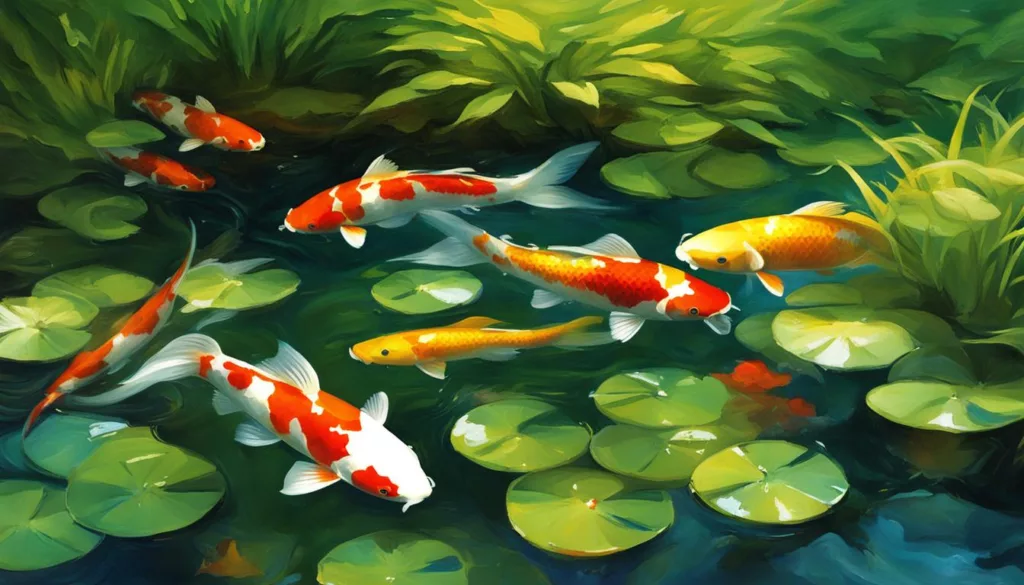

Fall
During fall, lower temperatures can slow down your fish’s metabolism, leading to possible health problems. To help your fish through this season:
- Gradually reduce feeding as the temperature drops and monitor their activity level.
- Add netting to catch any falling leaves and debris that can contaminate the pond’s water.
- Start to decrease any aquatic plants and prepare for winter by checking that the pond heater and pumps are in working order.
By managing seasonal changes in your koi pond, you can ensure that your fish are healthy and comfortable year-round, providing an enjoyable and tranquil outdoor space for everyone.
Dealing with External Threats
Your koi pond is a peaceful haven for your fish, but it can also attract unwanted attention from predators such as raccoons, herons, and cats. Keeping your koi safe is crucial, and there are several preventative measures you can take to protect them.
Protecting your Koi from Predators
One of the most effective ways to ward off predators is to install a robust and reliable pond net over the entire pond or individual sections. A heavy-duty net provides a physical barrier to deter birds and mammals from accessing your fish.
You can also minimize the risk of predators by adding hiding places and creating a natural-looking habitat around the pond. Planting bushes, trees, and shrubs near the pond creates a visual barrier and encourages predators to look elsewhere for their prey.
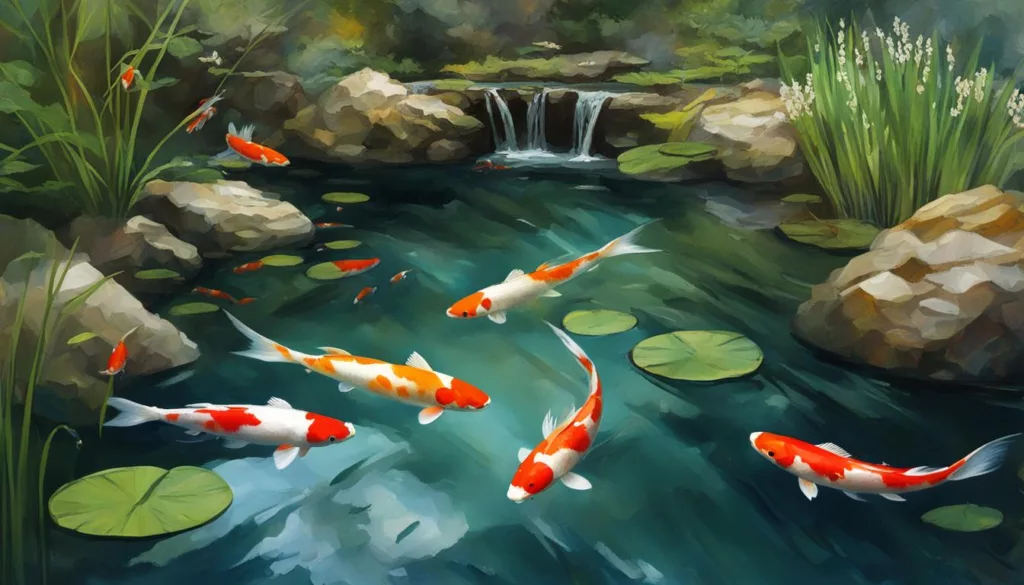

Preventing Debris Buildup
Keeping your pond free of debris is important for its overall health and appearance. Fallen leaves, twigs, and other organic matter can quickly accumulate and cause blockages in filters and pumps.
To prevent debris from entering the pond, consider installing a leaf or debris net over the pond. Regularly clear away any debris that collects on the net to prevent it from clogging.
Protecting Against Extreme Weather
Sudden weather changes can pose a threat to your koi pond. Freezing temperatures can cause water in the pond to expand, which can damage the pond’s structure and harm your fish. Similarly, extreme heat can cause oxygen levels in the water to drop, putting your koi’s health at risk.
To protect your koi against extreme weather conditions, it’s essential to maintain a stable water temperature and adequate oxygen levels. You can use a pond heater or aerator to regulate the temperature and provide sufficient oxygenation.
Regular Maintenance is Key
While preventative measures can go a long way in protecting your koi pond, regular maintenance is crucial to keep your fish safe and healthy. Inspect the pond, filter, and equipment regularly and be proactive in addressing any issues that arise.
Protecting your koi from external threats requires diligence and care, but with proper maintenance and preventative measures, your fish can thrive in a safe and serene environment.
Regular Maintenance Checklist
To keep your koi pond healthy and thriving, it is essential to perform regular maintenance tasks. These tasks will ensure optimal water quality and maintain the longevity of your pond equipment. Follow this comprehensive checklist to keep your pond in top condition.
Monthly Maintenance Tasks
| Task | Description |
|---|---|
| Clean Mechanical Filters | Remove debris and rinse the filter elements thoroughly with pond water to minimize the risk of clogging. |
| Check UV Sterilizer | Inspect the UV bulb and quartz sleeve, cleaning or replacing as necessary. |
| Inspect Pond Equipment | Verify that all pond equipment, such as pumps and skimmers, are functioning correctly and without unusual noise or vibration. |
Bi-Weekly Maintenance Tasks
- Test water for pH, ammonia, nitrate, and nitrite levels. Adjust accordingly based on test results.
- Check the water level and top off if necessary.
- Inspect and clean pond netting.
Weekly Maintenance Tasks
- Check and clean biological filters thoroughly.
- Vacuum any debris or waste settled at the bottom of the pond.
- Check and add necessary supplements or treatments, such as beneficial bacteria or dechlorinator.
Regular koi pond maintenance can be time-consuming, but the rewards of a healthy and thriving pond are well worth the effort. If you are short on time or need professional assistance, consider hiring koi pond maintenance companies to ensure your pond is properly maintained.
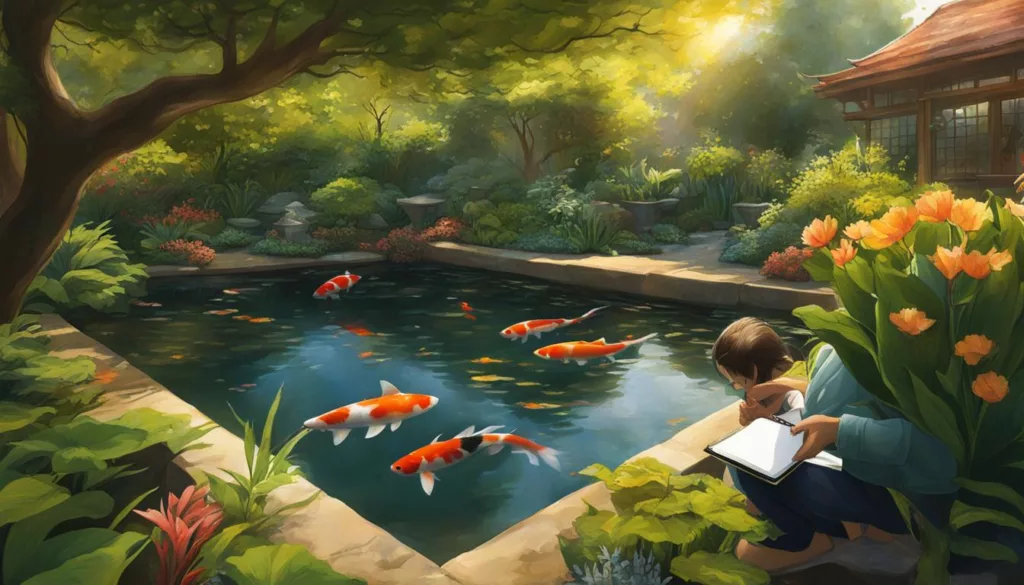

Conclusion: Take Action to Ensure Healthy and Happy Koi
By now, you know that koi pond maintenance is essential for creating a healthy and beautiful environment for your fish. Keeping your pond clean, clear, and balanced requires some effort, but the rewards are priceless. Imagine sitting by your pond, watching your colorful koi swim gracefully, and feeling relaxed and content. With the right maintenance practices, you can make this vision a reality.
Remember, maintaining a koi pond is a continuous process. You cannot set it and forget it. However, with proper planning, consistent monitoring, and regular care, you can enjoy the benefits of a thriving koi pond for many years to come.
So, don’t wait any longer. Take action today to ensure your koi are healthy and happy. Review the tips we’ve discussed, create a maintenance plan, and stick to it. And if you ever feel overwhelmed or unsure, don’t hesitate to seek help from a professional koi pond maintenance company. They can provide expert advice and services to keep your pond in optimal condition.
With your dedication and commitment, you can create a serene and stunning koi pond that will enrich your life and bring joy to others.
Thanks For the Great Attention!
Also, Read,
Laminate Flooring Installation Guide
Best Laminate Flooring Materials
FAQ
What are some koi pond maintenance tips for healthy fish?
Maintaining a healthy koi pond involves regular water testing, ensuring proper filtration, managing water quality, preventing and treating diseases, feeding and nutrition, controlling algae growth, managing seasonal changes, and protecting against external threats.
How should I plan and design my koi pond?
Planning and designing your koi pond involves considering factors such as location, size, depth, and water circulation. You should also factor in the costs associated with koi pond maintenance while planning.
What types of filtration systems should I consider for my koi pond?
Different filtration options, such as mechanical, biological, and UV sterilizers, can be effective in keeping the water clean and clear in your koi pond. The choice of filtration system depends on your pond’s size and the specific needs of your fish. Maintenance costs for each system should also be taken into account.
How can I manage water quality in my koi pond?
You can maintain optimal water quality in your koi pond by regularly testing and monitoring parameters such as pH, ammonia, nitrite, and nitrate levels. Taking steps to control debris, add beneficial bacteria, and ensure proper oxygenation will also contribute to maintaining water quality.
Why is regular water testing important for my koi pond?
Regular water testing allows you to monitor essential parameters and intervene promptly if any issues arise. Testing for pH, ammonia, nitrite, and nitrate levels helps ensure the water quality meets your koi’s requirements for a healthy environment.
What should I consider in terms of feeding and nutrition for my koi?
Establishing a feeding routine, selecting high-quality commercial koi food, and avoiding overfeeding is crucial for the growth and vitality of your fish. Proper nutrition, including a balanced diet and the occasional treats, supports their overall health and resilience.
How can I control algae growth in my koi pond?
Algae growth can be managed by adding aquatic plants, using UV sterilizers, maintaining proper nutrient balance, and removing excess organic debris. These measures will help keep the pond water clear and minimize algae blooms.
How can I prevent and treat diseases in my koi?
Preventing fish diseases involves maintaining a clean and balanced environment, avoiding stressors, and quarantining new fish before introducing them to the existing population. If diseases do occur, prompt identification and treatment with appropriate medications are necessary to prevent further spread.
What maintenance tasks should I perform during different seasons?
Seasonal changes require specific tasks such as cleaning and preparing the pond for winter, removing debris in the spring, and monitoring temperature fluctuations during summer. Adapting your maintenance routine to meet these seasonal demands will help ensure the well-being of your fish.
How can I protect my koi pond from external threats?
To protect your koi from predators, such as birds or raccoons, consider installing netting or other physical barriers. Regularly removing debris and maintaining adequate water levels also helps prevent damage from extreme weather conditions.
What should be included in a regular koi pond maintenance checklist?
A comprehensive maintenance checklist should include tasks such as cleaning filters, inspecting equipment, removing debris, testing water quality, checking for signs of disease, and monitoring temperature fluctuations. Engaging professional koi pond maintenance companies can also provide additional support in implementing the checklist effectively.




With my backyard pond becoming a bit of a green mess lately, I need a pond care service. The water has turned murky, and the once vibrant aquatic plants are struggling. I’ve tried DIY solutions, but it’s clear I need some professional help to restore balance. My koi fish seem less than impressed with their current living condition and I really wanna DIY this but it’s just beyond my abilities. I am just glad you said here that it is true that pond care prices can be high, but there are methods to keep expenses in check. You said that one approach is to look for trustworthy koi pond maintenance firms that provide reasonably priced services.